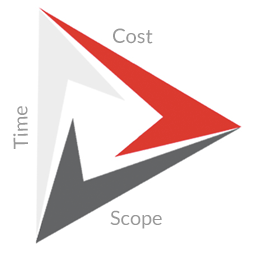The project management triangle, consisting of the three constraints of time, scope and cost, is essential to successful project delivery.
In the last blog post we provided an introduction to project management, explaining what it is and why it’s important. Now that you have a basic understanding of what project management is all about, we’re going to dig a little deeper and talk about the project management triangle.
The Project Management Triangle
 All projects have outputs or goals; they all have timeframes in which they need to be completed; and they all have set resource and finance allocations. These three considerations, which can be termed time, scope and cost, combine to form the three constraints that comprise the project management triangle. The combination of time, scope and cost is what largely dictates the quality of a project’s output.
All projects have outputs or goals; they all have timeframes in which they need to be completed; and they all have set resource and finance allocations. These three considerations, which can be termed time, scope and cost, combine to form the three constraints that comprise the project management triangle. The combination of time, scope and cost is what largely dictates the quality of a project’s output.
- Time is, unsurprisingly, the amount of time available for a project to be completed. The amount of time allocated needs to be realistic given the scope and cost of any given project.
- Scope is the fundamental elements that comprise a project – what the project is setting out to achieve. Scope can often change over the course of a project, as requirements are added or removed; this is called scope drift.
- Cost encompasses resources, labour, risk, materials and all of the factors that go into achieving a project scope within the allocated project time.
- Quality is what you get when you combine time, scope and cost to deliver a project. If the three key constraints change, so does the quality. We’ll explain this later.
Relationships Between Time, Scope and Cost
Time, scope and cost comprise the three sides of the project management triangle, but it is not just the constraints themselves but the relationships between them that make the concept so important.
You can’t adjust one constraint without affecting the others. If you increase or reduce one of the three constraints, the other two must also adjust. Consider the following three examples: –
- A car dealership has decided to undertake a project to upgrade the database systems on which it holds details on its vehicles and customers. Time, scope and cost have been set. However, the software vendor announces that the current software is set to reach the end of its supported life before the planned completion of the project. The time will have to decrease, which means that the scope may have to decrease to meet the shorter timeframe and the cost may increase as more out-of-hours work is required to complete the project.
- A creative agency is rolling out new Windows laptops to all of its users. After time, scope and cost have been set, three directors at the company have stated that they want Apple MacBooks rather than Windows laptops. The scope of the project has increased, which means that time and cost will increase as additional work will be required to allow the Apple MacBooks to access systems designed primarily for access by Windows operating systems.
- A housing developer is seeking to open a sales and marketing suite at a new development. With time, scope and costs already having been set, it emerges that connectivity to the development is not available via standard providers and an expensive wireless network will be required. The cost of the project has increased, and so the time and scope will have to adjust depending on the priorities of the business.
Understanding that time, scope and cost all have an influence on one another is important, but what is also essential is understanding which of the three constraints or sides is ‘fixed’. For the car dealership example, the time is fixed and so there will need to be flexibility with scope and costs. The scope of the creative agency’s project is fixed, dictated as it is by the directors, but they will need to understand that in increasing the scope they will also need to increase costs and possibly time. And the housing developer needs to establish which constraint is fixed – if it is cost then they will either need to reduce scope (to bring costs in line) or increase time (to wait until better connectivity is available).
Achieving Quality Output
Time, scope and cost combine to deliver quality in the output of a project. Understanding the quality of output required is important when setting the three constraints: increase time, scope and costs and you will increase quality, but remember that the same applies the other way. It’s important that all stakeholders understand this and are realistic about what is required to produce an output that meets the quality required.
At TSC Projects we believe that the project management triangle is an important concept that should be understood not only by project managers but also by stakeholders. If a project is planned and executed with the project management triangle in mind, it will stand a great chance of success. If you’d like to learn more about how we successfully utilise the project management triangle, please get in touch.
